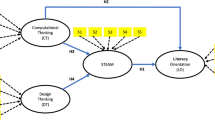Abstract
The underrepresentation of women in science, technology, engineering, art, and mathematics (STEAM)-related fields remains a concern for educators and the engineering community. Females tend to need more social support and learn better within a group. Using Project-based Learning (PjBL) seems to provide a supportive approach for female students to engage with STEAM. We adopted IDEO’s design process to evaluate the progress both female and male students made after participating in a PjBL-STEAM course. 137 high school students were recruited in this course to tackle the task to build a truss tower. Both female and male students evidenced significant progress in all constructs of engineering design thinking ability. In addition, there was no significant difference between female and male students’ posttest result. Our research echoes earlier research that female students can benefit from group work and develop substantial learning outcomes from PjBL-STEAM course.
Access this chapter
Tax calculation will be finalised at checkout
Purchases are for personal use only
Similar content being viewed by others
References
Ehrlinger, J., Plant, E., Hartwig, M.K., Vossen, J.J., Columb, C.J., Brewer, L.E.: Do gender differences in perceived prototypical computer scientists and engineers contribute to gender gaps in computer science and engineering? Sex Roles 78(1–2), 40–51 (2017). https://doi.org/10.1007/s11199-017-0763-x
Mahajan, P., Suresh, G.: Engineering a woman: marketing opportunities and challenges in India. Am. J. Manag. Sci. Eng. 2, 11–22 (2017). https://doi.org/10.11648/j.ajmse.20170201.12
Sagala, R., Umam, R., Thahir, A., Saregar, A., Wardani, I.: The effectiveness of STEM-based on gender differences: the impact of physics concept understanding. Eur. J. Educ. Res. 8, 753–761 (2019)
Beier, M.E., Kim, M.H., Saterbak, A., Leautaud, V., Bishnoi, S., Gilberto, J.M.: The effect of authentic project-based learning on attitudes and career aspirations in STEM. J. Res. Sci. Teach. 56, 3–23 (2019). https://doi.org/10.1002/tea.21465
Freeman, S., et al.: Active learning increases student performance in science, engineering, and mathematics. Proc. Natl. Acad. Sci. 111, 8410–8415 (2014)
Falloon, G., Forbes, A., Stevenson, M., Bower, M., Hatzigianni, M.: STEM in the making? Investigating STEM learning in junior school makerspaces. Res. Sci. Educ. (2020). https://doi.org/10.1007/s11165-020-09949-3
Johns, G., Mentzer, N.: STEM integration through design and inquiry. Technol. Eng. Teach. 76, 13–17 (2016)
Chen, C.-H., Yang, Y.-C.: Revisiting the effects of project-based learning on students’ academic achievement: a meta-analysis investigating moderators. Educ. Res. Rev. 26, 71–81 (2019). https://doi.org/10.1016/j.edurev.2018.11.001
Blumenfeld, P.C., Soloway, E., Marx, R.W., Krajcik, J.S., Guzdial, M., Palincsar, A.: Motivating project-based learning: sustaining the doing. Support. Learn. Educ. Psychol. 26, 369–398 (1991). https://doi.org/10.1080/00461520.1991.9653139
Tseng, K.-H., Chang, C.-C., Lou, S.-J., Chen, W.-P.: Attitudes towards science, technology, engineering and mathematics (STEM) in a project-based learning (PjBL) environment. Int. J. Technol. Des. Educ. 23, 87–102 (2013). https://doi.org/10.1007/s10798-011-9160-x
Fan, S.-C., Yu, K.-C.: How an integrative STEM curriculum can benefit students in engineering design practices. Int. J. Technol. Des. Educ. 27(1), 107–129 (2015). https://doi.org/10.1007/s10798-015-9328-x
Brears, L., MacIntyre, B., O’Sullivan, G.: Preparing teachers for the 21st century using PBL as an integrating strategy in science and technology education. Des. Technol. Educ. Int. J. 16 (2011)
Capraro, R.M., Slough, Scott.W.: Why PBL? Why STEM? Why now? an Introduction to STEM Project-Based Learning. In: Capraro, R.M., Capraro, M.M., Morgan, J.R. (eds.) STEM Project-Based Learning: An Integrated Science, Technology, Engineering, and Mathematics (STEM) Approach, pp. 1–5. SensePublishers, Rotterdam (2013)
Dinar, M., et al.: Empirical studies of designer thinking: past, present, and future. J. Mech. Des. 137 (2015). https://doi.org/10.1115/1.4029025
Mentzer, N., Becker, K., Sutton, M.: Engineering design thinking: high school students’ performance and knowledge. J. Eng. Educ. 104, 417–432 (2015). https://doi.org/10.1002/jee.20105
Greene, M.T., Gonzalez, R., Papalambros, P.Y., McGowan, A.-M.: Design thinking vs. systems thinking for engineering design: what’s the difference? In: Manuscript for 21st International Conference on Engineering Design. The University of British Columbia, Vancouver, Canada (2017)
IDEO: Design Thinking for Educators (2012)
O’Dea, R.E., Lagisz, M., Jennions, M.D., Nakagawa, S.: Gender differences in individual variation in academic grades fail to fit expected patterns for STEM. Nat. Commun. 9, 3777 (2018). https://doi.org/10.1038/s41467-018-06292-0
Reilly, D., Neumann, D.L., Andrews, G.: Investigating gender differences in mathematics and science: results from the 2011 trends in mathematics and science survey. Res. Sci. Educ. 49(1), 25–50 (2017). https://doi.org/10.1007/s11165-017-9630-6
Jagannathan, R.K., Komives, C.: Teaching by induction: project-based learning for Silicon Valley. J. Eng. Educ. Transform. 33, 22–26 (2019). https://doi.org/10.16920/jeet/2019/v33i1/149003
Lou, S.J., Liu, Y.H., Shih, R.C., Tseng, K.H.: The senior high school students’ learning behavioral model of STEM in PBL. Int. J. Technol. Des. Educ. 21, 161–183 (2011). https://doi.org/10.1007/s10798-010-9112-x
Author information
Authors and Affiliations
Editor information
Editors and Affiliations
Rights and permissions
Copyright information
© 2021 Springer Nature Switzerland AG
About this paper
Cite this paper
Yen, WH., Chang, CC., Willliams, J. (2021). Gender Differences in Engineering Design Thinking in a Project-Based STEAM Course. In: Huang, YM., Lai, CF., Rocha, T. (eds) Innovative Technologies and Learning. ICITL 2021. Lecture Notes in Computer Science(), vol 13117. Springer, Cham. https://doi.org/10.1007/978-3-030-91540-7_57
Download citation
DOI: https://doi.org/10.1007/978-3-030-91540-7_57
Published:
Publisher Name: Springer, Cham
Print ISBN: 978-3-030-91539-1
Online ISBN: 978-3-030-91540-7
eBook Packages: Computer ScienceComputer Science (R0)




